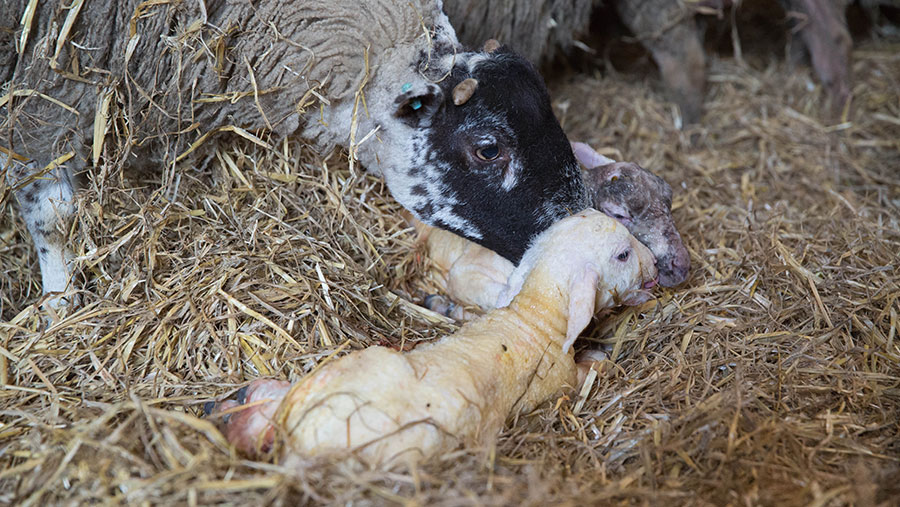Study shows benefits of pre-lambing metabolic profiling
 © Tim Scrivener
© Tim Scrivener Results of a recent study into lamb survival show that protein deficiency and negative energy balance in ewes can affect both lamb mortality in the first 24 hours and growth rates until weaning.
These conclusions highlight the value of nutrition and metabolic profiling of ewes ahead of lambing given the long-reaching effects imbalances can have on lamb performance.
The two-year project examining newborn lamb and calf survival in Great Britain, funded by levy boards in England, Wales and Scotland, was split into two parts:
1. Farmer surveys/interviews and vet/vet-student recording to benchmark performance, attitudes and barriers/enablers to change
2. Experimental research with the sheep flock at the University of Edinburgh, looking at the metabolic status of ewes, antibody status of lambs and lamb growth rates to weaning (see “Study design” box below).
Alexander Corbishley, a senior lecturer in farm animal practice at the University of Edinburgh, shared some of the key findings of the trial at the Sheep Health and Welfare Group conference this week.
Study design
Background
• March-April lambing lowland flock of about 250 ewes
• Ewes scanned and with good body condition score
• All singles and twins monitored from birth to weaning
• Triplets artificially reared on milk replacer
• Twin and triplet-carrying ewes fed traditional cake and good-quality haylage ration
• Singles not supplemented
Timings
Ewes were blood sampled in early March to assess metabolic status
At birth:
• Lambs were either given oral antibiotics or a placebo treatment (randomised)
• A 2ml blood sample was taken from about 5% of lambs
Between 8 and 24 hours old
• Lambs were weighed and double tagged
• A 2ml blood sample was taken from lambs
From 24 hours onwards
• All deaths and treatments were recorded
• Lambs were weighed at weaning
Protein status of ewes
Results showed that ewes with lower blood albumin levels – a long-term indicator of protein status – were more likely to lose a lamb in late pregnancy or the first 24 hours of life.
About half of the 250-head flock monitored in the experiment had low blood albumin levels going into lambing. This is despite being rationed according to their energy and protein requirements and predominantly being in good energy balance.
The study used an albumin cut-off of 30g/litre.
“There is a debate as to whether that is an appropriate cut-off or not,” said Dr Corbishley. “But the cut-off is irrelevant for the findings of this study. The findings of this study show that ewes that lose a lamb between scanning and 24 hours are more likely to have a lower blood albumin.”
Results from a similar trial in France are showing exactly the same.
This proves that albumin is associated with a production impact within the flock, Dr Corbishley said.
He advised the best time for farmers to assess metabolic status pre-lambing is three weeks before lambing because that is the time ewes are about to go into the peak twin-lamb risk period.
See also: A complete guide to ewe nutrition requirements throughout the year
Energy balance in ewes and lamb growth
The metabolic profiling of ewes also revealed:
- Ewes in negative energy balance – shown by high BHB (B-hydroxybutyrate) levels – were five times more likely to have a lamb with insufficient antibody levels (based on 24mg/ml cut-off)
- Low antibody levels in lambs, caused by poor colostrum transfer, meant lambs were nearly five times as likely to be poor growers until weaning (achieving a daily liveweight gain of less than 0.26kg a day).
Other findings
- Oral antibiotics had no effect on lamb performance
- About one in 10 lambs were found to have blood antibody levels below what is acceptable for a dairy calf – 10mg/ml of IgG (immunoglobulin G) – and one in three lambs were below what would be acceptable for a beef calf (24mg/ml IgG)
- Triplets were more likely to have problems with colostrum antibodies
- Being supplemented with colostrum was not connected to poorer-growing lambs
- Litter size affected losses between scanning and 24 hours old:
• There were no losses in single-carrying ewes
• 9% of twin-carrying ewes lost one or more lambs
• 32% of triplet-carrying ewes lost one or more lambs - There was more variability in neonatal mortality in outside flocks than indoor or mixed (ewes outside by day and in at night)
- Neonatal mortality showed no correlation with farm size and staff levels
- Cultural stigma surrounding the topic of lamb mortality limits recording and discussion
- There is an autonomous motivation to improve and farmers are positive about influencing neonatal survival
